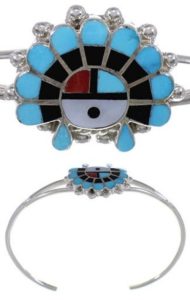
Many tribes in the Native American culture have cultivated their own styles for jewelry crafting. Their unique cultural history and interactions with different countries have shaped the way they make jewelry. As with most cultures, Native American art and jewelry is derived from their spiritual beliefs and what materials are made available to them. Zuni bracelets have many rich and vibrant aspects to them that are easily identified by a few key features of the piece. Learning how to identify an authentic Zuni piece is a simple matter of learning what these elements are and then watching out for them when you shop.
What to Look for in Zuni Bracelets
Style- With the Zuni’s unique style, pieces that feature smaller stones, clusters, and use an inlay technique to create the pieces, then you might be looking at a Zuni bracelet. The inlay technique of silverwork uses impressions within the silver itself to create wonderful images, symbols, and patterns that reflect the beliefs of the Zuni people.
Clustering- Clustering stones, like turquoise, is another indication of Zuni art. The Navajo while sometimes cluster two or three stones to a piece, however, it is common for the Zuni to cluster many smaller stones on their jewelry, sometimes forming an image in the process.
The Matrix- While Navajo artists may use larger stones in their work, the Zuni consider themselves to be master stone cutters and feature a lot less of the stone’s original matrix in the piece, cutting down the stone into a smooth and nearly seamless surface in the process.
The Hallmark- The Navajo and Zuni bracelets will typically use the artist’s initials on the back of the piece. This is a good way to rule out Hopi pieces that primarily use a symbol in place of a signature as their hallmark.